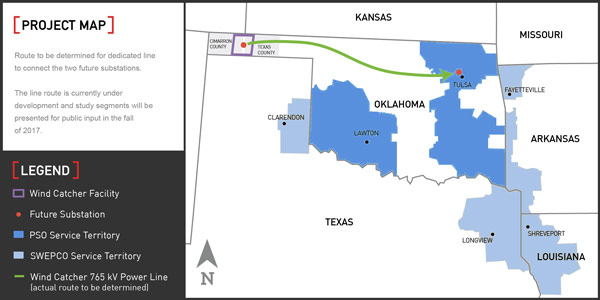By Peter Key and Tom Kleckner
American Electric Power, once the biggest coal-burning utility in the U.S., now plans the nation’s largest wind farm, a 2,000-MW project in the western Oklahoma Panhandle that would be connected to subsidiaries in Arkansas, Louisiana, Oklahoma and Texas by a 350-mile EHV transmission line.
AEP’s total investment in the project would be $4.5 billion — $2.9 billion for the wind farm and $1.6 billion for the Wind Catcher Energy Connection line. Its Southwestern Electric Power Co. and Public Service Company of Oklahoma subsidiaries would own 70% and 30% of the project, respectively.
The wind farm, made up of 800 2.5-MW General Electric turbines, will be built for AEP by Invenergy. In addition to being the largest in the U.S., it will be the second largest in the world, behind only the 6,000-MW Gansu wind farm in China.
PSO and SWEPCO seek approvals from regulators in the four states the project will serve, as well as from FERC, by April, AEP CEO Nick Akins said in the company’s second-quarter earnings conference call Thursday. The company will re-evaluate the project at that time.
“We are going to have to sit down at the end of that April time period and figure out, ‘OK, what are the risks to our shareholders moving forward with this particular project, given not only the regulatory outcomes but also the other risk components that are involved with this,’” Akins said.
One of those other risk components is the project’s completion date. It has to be up and running by 2020 to qualify for the federal production tax credit, which ends at the end of 2019. Akins said AEP will recover $2.5 billion through the credit.
SPP confirmed that the project is in its generator interconnection queue for study of its impact on the system.
SPP Wind Growth
The RTO has seen considerable wind-energy development in the Oklahoma and Texas panhandles, which has caused congestion in the area. SPP will be conducting a high-priority congestion study to address the situation. (See “Committee Gives Congestion Study New Life,” SPP Strategic Planning Committee Briefs: July 13, 2017.)
AEP’s announcement came as the American Wind Energy Association reported that wind projects under construction or advanced development rose 40% year-over-year in the second quarter. Kansas became the fifth state with more than 5,000 MW of installed wind, joining Texas, Iowa, Oklahoma and California.
The transmission segment of the project is similar in scale to Clean Line Energy’s proposed Plains & Eastern Clean Line, a $2.5 billion, 700-mile HVDC transmission line that would deliver 4,000 MW of wind power from the Oklahoma Panhandle to the Tennessee Valley Authority near Memphis, Tenn.
‘Exciting Development’
“It’s a pretty exciting development for transmission,” Clean Line founder and President Mike Skelly told RTO Insider. “We’ve always believed building wind in the windiest places of the country with long-distance lines to load is a great answer for ratepayers and energy overall. These guys believe in the same thing.
“When the biggest utility says, ‘You know what? We believe that too’ … that’s a very positive thing for our industry. It bodes really well.”
Plains & Eastern has met opposition from Arkansas legislators and landowners. Clean Line’s Grain Belt Express project has run into stiff pushback in Missouri. (See Arkansas Landowners Seek to Stop Plains & Eastern Clean Line Project.)
Asked about advice he would give AEP given regulatory approvals and landowner opposition, Skelly said, “AEP is one of the biggest utilities we have. Far be it from me to offer them advice.”
Akins said the project would not cause AEP to shutter any of its other generators. He said only 7% of the power coming out of the wind farm “counts as capacity, so you still need the other units to provide capacity, and they fill in from an energy perspective as well.
“We’re not shutting any other units down; those units are absolutely needed. But what it does is provide more diversity from a resource perspective.”
AEP also is touting the project’s effect on its service areas’ economies, saying it will save ratepayers $7 billion over 25 years and support 8,400 jobs during construction. The project will support 80 permanent jobs once it’s operational and contribute approximately $300 million in property taxes over its life, according to the company.
AEP said it earned $375 million ($0.76/share) on revenue of $3.6 billion in the second quarter. Its earnings, adjusted for non-recurring gains, were 75 cents/share. That was short of the average estimate of seven analysts surveyed by Zacks Investment Research, which was 82 cents/share.




